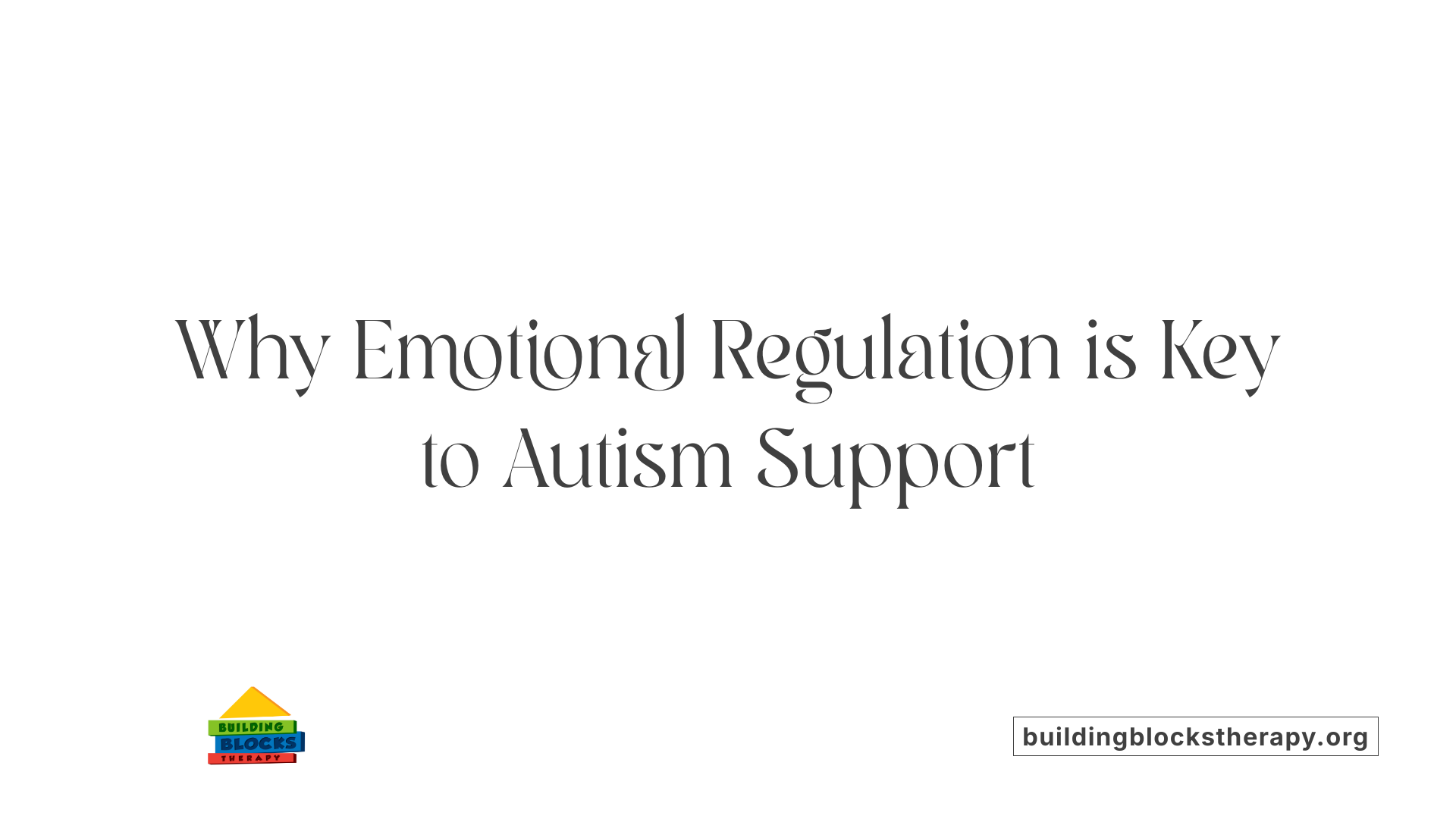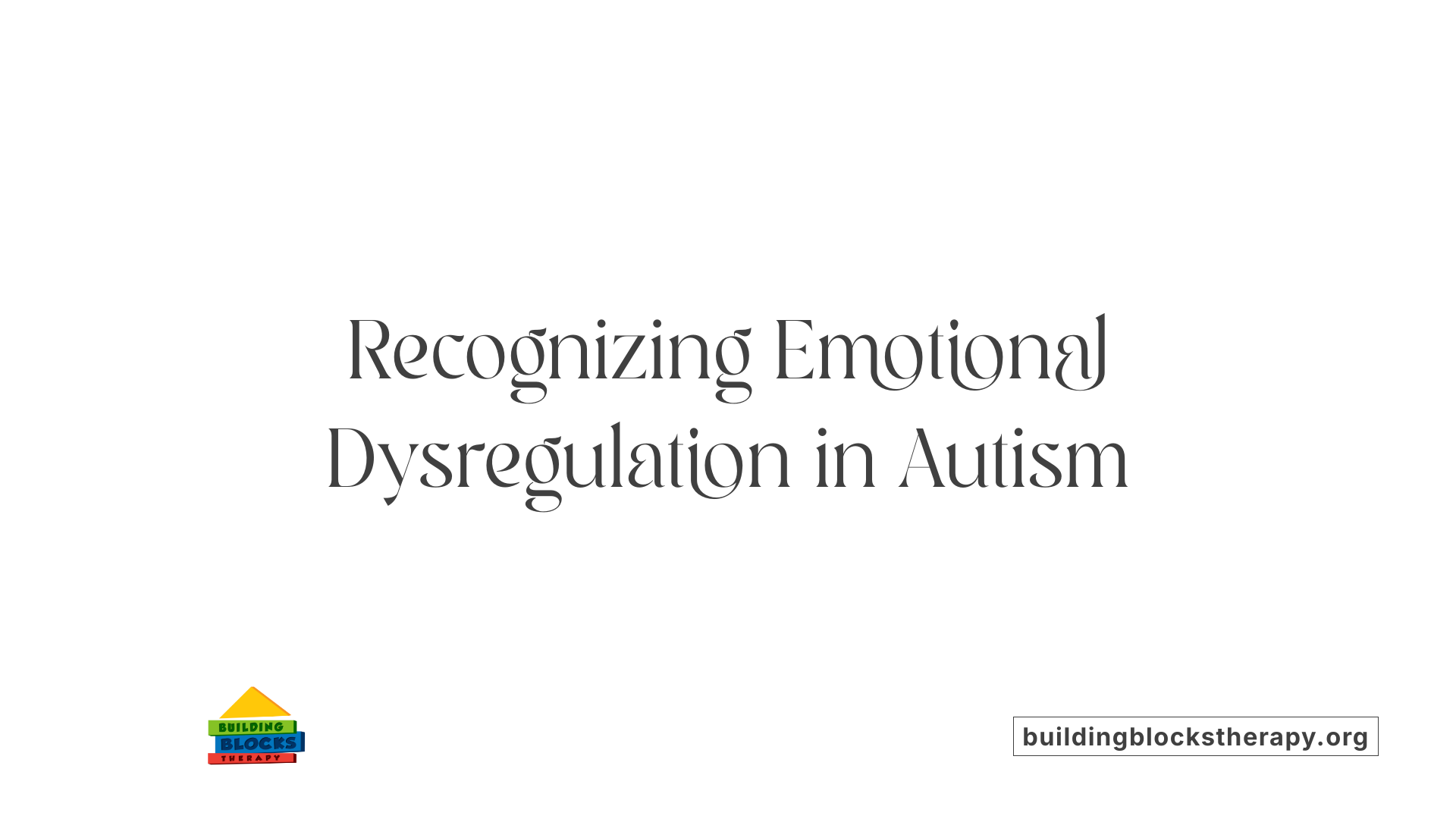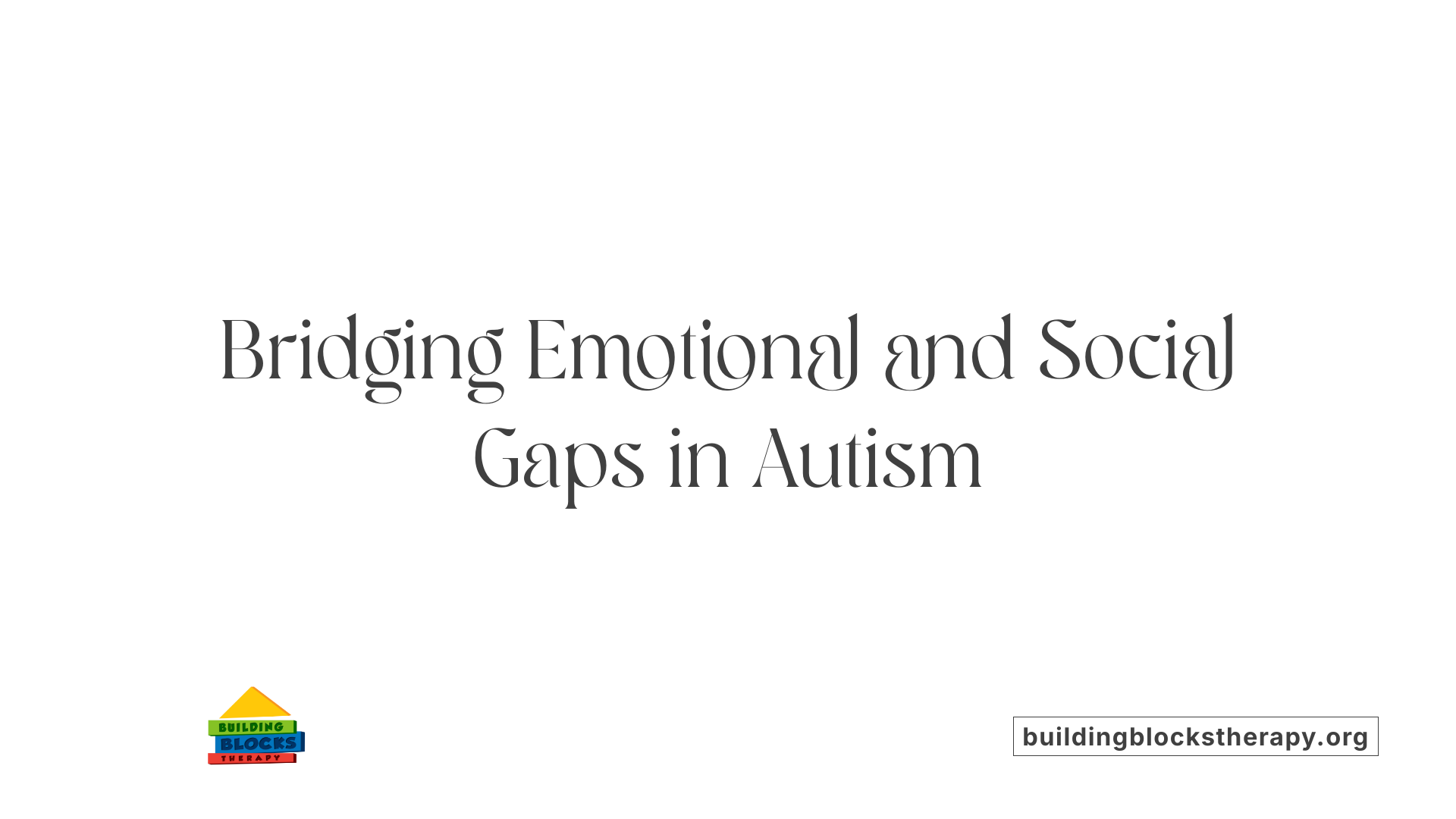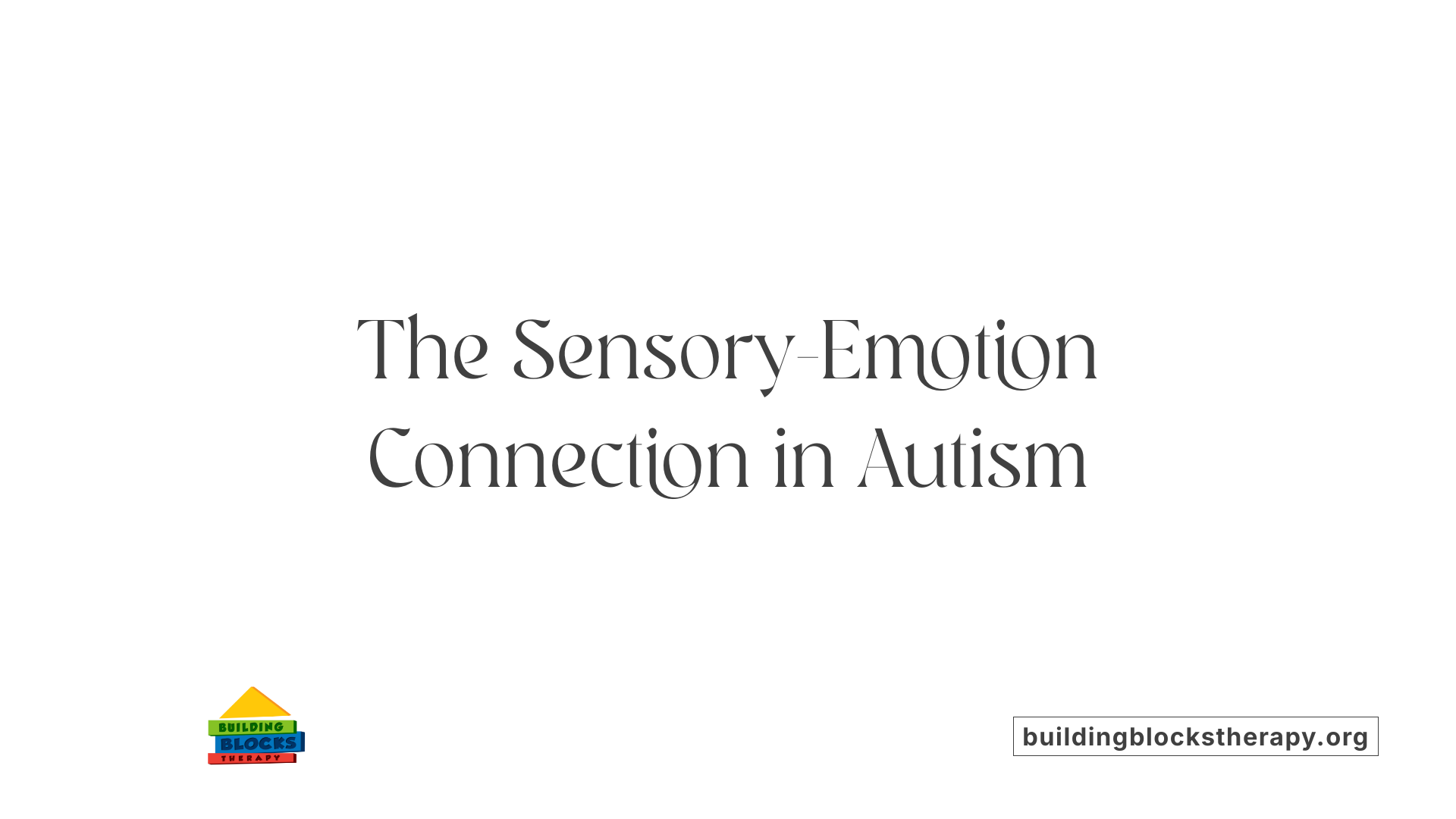Can Autism Affect Emotions
Unraveling Emotional Challenges in Autism Spectrum Disorder

Understanding Emotional Dynamics in Autism
Autism Spectrum Disorder (ASD) is widely recognized for its impact on social communication and behavior, yet its profound effect on emotions is often less visible but equally significant. This article explores how autism affects emotional functioning, highlighting the underlying neurological processes, behavioral manifestations, and therapeutic approaches that address emotional regulation challenges in individuals with autism.
The Neurobiological Foundations of Emotional Functioning in Autism
Brain Connectivity Disruptions in ASD
Autism spectrum disorder (ASD) is marked by disruptions in connectivity and communication between different brain regions. These alterations significantly affect how emotions are processed and regulated. Such widespread network abnormalities are not isolated but involve critical areas responsible for emotion regulation.
Impacts on Emotional Processing
Individuals with ASD often face challenges in managing their emotions effectively. These challenges stem from impaired connectivity and processing across brain networks. Affected emotional functioning can manifest as irritability, aggression, anxiety, and difficulty adapting emotional responses to situational demands. These difficulties highlight that emotional regulation problems are not merely behavioral issues but rooted in the neural architecture.
Role of Prefrontal Cortex and Amygdala
The prefrontal cortex (PFC) and amygdala play central roles in regulating emotional responses. In ASD, abnormal activity and disrupted connectivity between these regions have been observed using neuroimaging techniques like functional magnetic resonance imaging (fMRI). The PFC, responsible for executive functions and cognitive control of emotions, shows atypical engagement, whereas the amygdala, a center for emotion detection and threat response, exhibits altered activation patterns. This dysregulation contributes to the difficulties in emotional insight and adaptive regulation strategies found in many individuals with ASD.
Physiological Arousal Indicators
Physiological measurements such as heart rate variability (HRV) reveal increased baseline arousal in individuals with ASD, indicating heightened physiological reactivity. These elevated arousal states suggest a neurobiological predisposition towards emotional hyperreactivity, which can overwhelm regulatory capacities. Together with neural imaging, these physiological indicators provide a fuller picture of the complex mechanisms underlying emotional difficulties in autism.
| Aspect | Description | Significance in ASD |
|---|---|---|
| Brain connectivity | Disrupted communication between regions | Leads to impaired integration of emotional and cognitive data |
| Emotional processing | Difficulty in regulating intensity and duration | Results in behaviors like meltdowns, anxiety, and aggression |
| Prefrontal cortex (PFC) | Impaired executive control over emotions | Contributes to poor cognitive reappraisal and regulation |
| Amygdala | Abnormal threat and emotion detection | Heightens emotional responses and sensitivity |
| Physiological arousal (HRV) | Increased baseline arousal | Indicates predisposition to emotional hyperreactivity |
What Is Emotional Regulation and Why Is It Critical in ASD?

Understanding Emotional Regulation (ER)
Emotional regulation (ER) is the process by which an individual modifies the intensity and duration of their emotional responses. This can happen either automatically or intentionally, with the goal of promoting adaptive or goal-directed behavior. Through ER, people manage how emotions influence their actions, helping them to respond appropriately to various situations.
The Role of ER in Behavioral Adaptation
Effective ER enables individuals to handle emotional challenges in a way that supports social functioning and personal well-being. It helps prevent emotional reactions from becoming overwhelming or disruptive. Without adequate ER skills, individuals may experience heightened distress and difficulty in managing everyday stressors, leading to behaviors like meltdowns, aggression, or self-injury.
ER Challenges in Autism Spectrum Disorder
For individuals with autism spectrum disorder (ASD), ER is often a significant challenge. ASD involves disruptions in brain connectivity and processing, particularly in regions responsible for emotion regulation such as the prefrontal cortex and amygdala. These neural differences contribute to impairments in the ability to identify, modulate, and express emotions appropriately.
Why ER Is Especially Critical in ASD
Individuals with ASD frequently rely more on maladaptive ER strategies such as suppression, avoidance, or resignation. They may experience intense emotional reactions known as "meltdowns," which are not deliberate but rather manifestations of poor ER. Moreover, deficits in recognizing emotions — partially due to alexithymia — and difficulties in perspective-taking complicate effective ER. As a result, ER deficits in ASD are closely linked to behavioral disturbances and emotional difficulties, which significantly affect quality of life and social interactions.
Manifestations of Emotional Dysregulation in Individuals with Autism

What behaviors indicate emotional dysregulation in individuals with autism?
Individuals with Autism Spectrum Disorder (ASD) often display emotional dysregulation through behaviors such as irritability, aggression, and self-injury. These problem behaviors are not deliberate acts of defiance but attempts to cope with overwhelming emotions and stress. Anxiety and impulsivity frequently accompany these difficulties, further complicating emotional control.
What are "meltdown" episodes in children and youth with ASD?
"Meltdown" episodes represent intense, often uncontrollable reactions to stress, reflecting poor emotion regulation (ER). These episodes are characterized by sudden behavioral outbursts that may include crying, yelling, aggression, or self-harming actions. Meltdowns differ from temper tantrums by their intensity, duration, and underlying inability to modulate emotions effectively.
What maladaptive emotion regulation strategies do individuals with ASD tend to use?
Research shows that people with ASD may rely on maladaptive emotion regulation strategies such as suppression, resignation, and avoidance rather than adaptive approaches like cognitive reappraisal. Youth on the spectrum sometimes lack emotional insight, inhibiting their ability to identify emotions accurately and select effective regulatory methods. This reliance on less effective coping mechanisms can lead to heightened emotional distress and behavioral disturbances.
How does impaired emotional regulation relate to behavioral disturbances?
Impaired ER in autism is a significant contributor to aberrant behaviors including tantrums, uncontrolled outbursts, aggression, and self-injury. These behaviors often arise as direct attempts to alleviate emotional distress. Notably, ER problems predict anxiety, depression, hospitalizations, and emergency visits more reliably than the severity of autism symptoms alone. Thus, behavioral disturbances in ASD are frequently manifestations of ineffective management of intense emotional states.
This understanding emphasizes the importance of targeting ER skills in treatment approaches to reduce the frequency and severity of challenging behaviors in autistic individuals.
Core Autism Characteristics Influencing Emotional Regulation

How Does Sensory Hypersensitivity Affect Emotional Regulation in Autism?
Autistic individuals often experience sensory hypersensitivity, which means they may be more sensitive to stimuli like noise, light, touch, or smells. This heightened sensory response can trigger overwhelming emotional reactions, such as anxiety or fear, making it difficult to regulate emotions effectively. For example, a loud environment might cause distress leading to a 'meltdown' — intense emotional outbursts that reflect poor emotion regulation.
In What Ways Does Resistance to Change Impact Emotional Regulation?
Resistance to change is a common characteristic of autism that can affect how emotions are managed. When routines or environments shift unexpectedly, individuals with ASD may experience heightened stress or frustration. This rigidity in adapting to new situations limits their ability to employ flexible emotion regulation strategies, often resulting in increased irritability or withdrawal.
How Does Cognitive Rigidity Influence Emotional Responses?
Cognitive rigidity refers to difficulties in thinking flexibly or shifting perspectives. In ASD, this trait contributes to challenges in managing emotions because individuals may struggle to reconsider or reframe situations that cause distress. This limitation can lead to reliance on maladaptive strategies like avoidance or resignation, which are less effective for regulating intense emotions.
What Role Does Impaired Perspective-Taking Play in Emotion Regulation?
Impairments in perspective-taking, a component of social cognition, hinder understanding others' emotions and intentions. This difficulty affects emotional regulation by reducing insight into emotional cues and appropriate responses. Individuals with ASD may find it challenging to interpret social contexts, leading to misunderstandings and reactive emotional behaviors.
How Do Information Processing Differences Affect Emotional Management?
Autistic individuals process emotional information differently, often at different speeds or through alternate pathways, leading to delayed emotional awareness or sensory overload. These processing differences can cause difficulty in recognizing and modulating emotional states effectively. For instance, alexithymia—a condition common in ASD affecting the ability to identify and describe emotions—makes self-regulation more complex.
Together, these core ASD characteristics interplay to shape the unique emotional regulation profiles observed in autistic individuals, underscoring the importance of tailored strategies that consider sensory, cognitive, and social processing differences.
Alexithymia and its Role in Emotional Challenges in ASD
Difficulty Identifying and Describing Emotions
Alexithymia is a condition characterized by significant difficulty in identifying, distinguishing, and describing one's own emotional experiences. In individuals with Autism Spectrum Disorder (ASD), this impairment is particularly pronounced, complicating their ability to recognize internal emotional states and communicate them effectively. This challenge stems from core deficits in emotional insight and social cognition, which are commonly observed in ASD.
Prevalence of Alexithymia in Autism
Research indicates that approximately 50% of autistic individuals experience alexithymia, a rate considerably higher than in the general population. This substantial prevalence underscores alexithymia as a frequent co-occurring feature in ASD, contributing to the broad spectrum of emotional processing difficulties faced by this group.
Impact on Emotional Awareness and Regulation
The presence of alexithymia in ASD critically impacts emotional awareness, leading to delays in recognizing emotional states and contributing to sensory overwhelm when exposed to intense feelings. This lack of emotional clarity hinders effective emotion regulation (ER), as individuals may struggle to employ adaptive strategies or understand their emotional triggers. Consequently, alexithymia can amplify tendencies toward maladaptive regulation methods such as suppression, avoidance, or resignation, thereby exacerbating behavioral challenges associated with poor ER in ASD.
The 'Double Empathy Problem' and Emotional Interaction

What are the empathy challenges in autism?
Autistic individuals often experience unique empathy challenges that differ from typical social processes. This stems partly from their distinct ways of processing emotional and social information. These differences affect their ability to perceive, interpret, and respond to others' emotions in conventional ways.
How does the 'Double Empathy Problem' affect mutual understanding?
The 'Double Empathy Problem' refers to the mutual difficulties autistic and non-autistic people have in understanding each other's perspectives. Instead of seeing communication barriers solely as deficits within autistic individuals, this concept emphasizes the two-way nature of misunderstanding. Both parties experience challenges processing social and emotional cues, which hampers effective emotional exchange and rapport.
What is the impact on emotional communication?
Due to this mutual disconnect, emotional communication between autistic individuals and others may be marked by misinterpretations or delayed emotional responses. These difficulties can intensify misunderstandings, increase social stress, and complicate emotional regulation efforts. Consequently, emotional exchanges may require more patience, tailored communication methods, and an awareness of these empathic differences to foster better interaction and shared emotional insight.
Physiological and Neural Correlates of Emotional Responses in ASD
What physiological measures indicate about emotional responses in ASD
Research shows that individuals with autism spectrum disorder (ASD) often exhibit increased baseline physiological arousal. Measures such as heart rate variability (HRV) and electrodermal activity have been used to assess autonomic nervous system functioning during emotional regulation tasks. While some studies report heightened resting arousal levels in ASD, heart rate and electrodermal responses during emotion regulation activities often do not differ significantly from typically developing peers, suggesting that difficulties in emotion regulation may not be solely due to physiological hyperreactivity.
Insights from neural imaging studies
Functional magnetic resonance imaging (fMRI) studies have revealed abnormalities in brain regions critical to emotion regulation in ASD, particularly the prefrontal cortex (PFC) and amygdala. These areas show atypical activity patterns and disrupted connectivity, contributing to challenges in modulating emotional responses. Such neural differences align with observed behavioral difficulties in emotional regulation and increased emotional reactivity.
Hyperarousal and neural circuitry abnormalities
The combination of increased baseline arousal and atypical brain network functioning suggests that hyperarousal and neural circuitry abnormalities significantly impact emotion regulation in ASD. Altered connectivity between the PFC and amygdala can impair the top-down modulation of emotional responses, making it difficult for individuals with ASD to apply adaptive regulation strategies effectively.
Understanding these physiological and neural correlates directs interventions toward targeting hyperarousal—such as using pharmacological treatments like alpha-2 agonists—and enhancing functional connectivity through behavioral therapies, aiming to improve emotional regulation capacities in ASD.
Emotional Regulation Strategies Among Children with Autism
How do children with autism differ in their emotion regulation strategies compared to typically developing children?
Children with autism spectrum disorder (ASD) often display a different set of emotion regulation (ER) strategies than their typically developing (TD) peers. Notably, younger children with ASD, ranging from 12 to 72 months, tend to utilize simpler and less effective strategies such as avoidance, venting, and distraction when coping with distress. These differences suggest delays or divergences in the development of intrinsic ER skills, which makes their emotional responses less flexible and adaptive.
To what extent do children with autism rely on others for emotion regulation?
Unlike typically developing children who gradually develop independent ER skills, children with ASD rely more heavily on external support from caregivers and others for managing their emotions. This reliance points to a delayed acquisition of autonomous ER and stresses the importance of social context in helping them regulate their feelings.
What simpler and less effective ER strategies are observed in children with autism?
In coping with emotional distress, children with autism frequently use strategies such as:
- Avoidance: Trying to escape from the emotional trigger or situation.
- Venting: Expressing emotions outwardly without structured coping.
- Distraction: Redirecting attention away from the emotional stimulus.
These strategies are generally less effective at promoting adaptive regulation and can contribute to behavioral difficulties.
How do caregivers contribute to the co-regulation of emotions in children with autism?
Caregivers play a critical role in supporting ER among children with ASD. They employ a wide array of strategies including physical comfort, verbal explanations, and adjusting responses to meet situational needs. This co-regulation is essential in helping children manage emotions they cannot yet regulate independently. Furthermore, caregiver-mediated interventions have shown promise in improving ER skills, emphasizing the importance of caregiver involvement in therapeutic approaches.
| Aspect | Typical Children | Children with Autism | Additional Notes |
|---|---|---|---|
| ER Strategy Complexity | More sophisticated, flexible strategies | Simpler, less effective (e.g., avoidance, venting) | Developmental delays or differences in ASD. |
| Reliance on Others for ER | Gradual move towards self-regulation | Sustained reliance on caregivers | Highlights need for co-regulatory support. |
| Caregiver Role | Supportive but reduced over time | Crucial and ongoing role | Caregiver involvement is key for successful ER. |
| Intervention Evidence | Standard behavioral therapies effective | Caregiver-mediated interventions show promise | Tailored approaches necessary for ASD populations. |
Language Skills and Executive Functioning as Predictors of ER Abilities
How do receptive language skills correlate with emotion regulation in children with ASD?
Research indicates a positive correlation between receptive language skills and emotion regulation (ER) abilities in children with autism spectrum disorder (ASD). Children who better understand language tend to have more effective ER, likely because they can comprehend emotional cues and verbal instructions about managing emotions. In contrast, expressive language skills show a less clear relationship with ER, suggesting that understanding language may be more critical than verbal expression for emotional control.
What is the impact of executive functioning on ER in ASD?
Executive functioning, which includes skills such as working memory, cognitive flexibility, and inhibitory control, significantly influences ER in children with ASD. Poor executive functioning is linked to difficulties in employing adaptive ER strategies. For example, cognitive rigidity can limit an autistic child's ability to switch from maladaptive responses like avoidance to more effective coping mechanisms. This connection emphasizes the role of cognitive control in managing emotional reactions.
How does ASD severity relate to emotion regulation abilities?
Emotion regulation in children with ASD is also associated with the severity of autism symptoms. Studies suggest that higher ASD symptom severity corresponds to greater challenges in ER. This relationship may stem from core deficits in social cognition and sensory processing that complicate the recognition and modulation of emotions. Consequently, children with more pronounced ASD symptoms often struggle more with regulating intense emotional responses.
Collectively, receptive language skills and executive function emerge as important predictors of ER abilities in ASD, intertwined with symptom severity. These factors highlight the need for targeted interventions that improve language comprehension and executive control to support emotional regulation in autistic children.
Why Emotional Dysregulation in ASD Is More Than Behavioral Misconduct
Misinterpretation of Behavioral Disturbances
Meltdowns, aggression, and self-injury in individuals with Autism Spectrum Disorder (ASD) are frequently misunderstood as deliberate misbehavior or temper tantrums. However, these behaviors often stem from disrupted emotion regulation (ER), reflecting difficulty in managing overwhelming emotional states rather than intentional acts. Recognizing these episodes as manifestations of emotional dysregulation can transform approaches to care and support.
Neurobiological and Cognitive Causes
Underlying these behavioral disturbances are neurobiological differences in brain regions responsible for ER, including abnormal activity and connectivity in the prefrontal cortex (PFC) and amygdala. Physiological measures reveal increased baseline arousal in individuals with ASD, indicating heightened sensitivity to stress and emotional stimuli. Additionally, cognitive features such as alexithymia—difficulty identifying and describing emotions—and impairments in perspective-taking and social cognition further hinder effective ER in autism.
Distinction from Deliberate Behavior
The emotional outbursts observed in ASD should be seen not as acts of rebellion or manipulation but as indications of limited capacity or skills to regulate intense emotions. These challenges arise intrinsically from core ASD characteristics, not purely from co-occurring psychiatric conditions. Understanding this distinction challenges stigmatizing perceptions and emphasizes the need for specialized interventions targeting emotion regulation rather than punitive responses.
Behavioral Therapy for Autism: Foundations and Providers
What is behavioral therapy for autism?
Behavioral therapy for autism primarily revolves around Applied Behavior Analysis (ABA), a scientifically driven method aimed at enhancing specific skills while reducing challenging behaviors. This approach uses structured techniques and positive reinforcement to encourage adaptive behaviors.
ABA therapy involves individualized programs tailored to improve communication, social interaction, self-care, and academic abilities. It includes various types such as Pivotal Response Training, Discrete Trial Teaching, and Early Intensive Behavioral Intervention. Though these methods differ in their instructional style, they all focus on reinforcement principles and environmental modification to support learning.
The therapy is delivered in multiple settings — including homes, schools, or community centers — and frequently involves family participation for consistency and generalization of skills. Research demonstrates that when behavioral therapy is provided intensively over a sustained period, it can lead to substantial improvements in the quality of life for many children with autism.
Who typically provides behavioral therapy for autism?
Trained and licensed professionals primarily deliver behavioral therapy. The most common providers are Board Certified Behavior Analysts (BCBAs) who design customized intervention plans rooted in comprehensive assessments of each child's strengths and needs.
Behavior technicians implement these plans under the supervision of BCBAs, carrying out daily intervention activities. Beyond these ABA specialists, a multidisciplinary team often collaborates in providing holistic support. This team can include psychologists, speech and language therapists, occupational therapists, and physical therapists, especially within early intervention programs.
Providers utilize evidence-based techniques such as reinforcement, errorless learning, functional communication training, and natural environment teaching. This multidisciplinary collaboration ensures that the therapy addresses the complex needs of children with autism, promoting social, communicative, and behavioral development effectively.
How Applied Behavior Analysis (ABA) Facilitates Emotional and Behavioral Improvements
How does Applied Behavior Analysis (ABA) work in treating autism?
Applied Behavior Analysis (ABA) utilizes principles of learning and behavior science to address the emotional and behavioral challenges faced by individuals with autism. This method begins with a careful assessment of behavior patterns, pinpointing triggers (antecedents) and consequences that maintain or modify behaviors.
Principles of learning and behavior science in ABA
At its core, ABA capitalizes on the science of behavior by using techniques such as positive reinforcement and prompting. Positive reinforcement increases desired behaviors by offering rewards following the behavior, while prompting provides cues or assistance to encourage the correct response.
Promoting skill development and generalization
ABA programs are highly individualized, focusing on vital skills like communication, social interaction, daily living, and emotional regulation. Through repeated opportunities and reinforcement, individuals learn new skills and generalize these behaviors across various environments and situations, fostering greater autonomy.
Long-term benefits for individuals with autism
The consistent application of ABA techniques has shown lasting improvements in behavior and emotional functioning. By reducing problematic behaviors such as irritability, aggression, and impulsivity, which are linked to difficulties in emotion regulation, ABA helps individuals manage their emotions more adaptively. This not only leads to better social outcomes but also supports mental health and reduces the need for emergency interventions.
By integrating behavioral science with personalized care, ABA stands as a comprehensive intervention that addresses both the developmental and emotional needs of people with autism.
Benefits of Behavioral Therapy in Addressing Emotional Dysregulation in ASD
What are the benefits of behavioral therapy for individuals with autism?
Behavioral therapy provides a range of benefits for individuals with autism spectrum disorder (ASD), particularly in managing emotional dysregulation and enhancing overall functioning. These therapies, including Applied Behavior Analysis (ABA) and other evidence-based approaches, focus on improving communication, social skills, and adaptive learning through structured tasks and positive reinforcement.
One primary advantage is the reduction of challenging behaviors such as aggression, irritability, and meltdowns often caused by difficulties in emotion regulation. By teaching alternative coping strategies and emotional awareness, behavioral therapy helps individuals replace maladaptive responses with healthier ways of managing emotions.
Improved communication and social interaction skills are crucial outcomes, as they allow individuals with ASD to better express their feelings and needs, reducing frustration and misunderstandings. These skills also promote more meaningful connections with peers and caregivers.
Behavioral interventions foster greater independence in daily activities by teaching practical skills and encouraging self-regulation. This increased autonomy contributes to building confidence and functional abilities in real-life situations.
Lastly, behavioral therapy prepares individuals for real-world challenges, thereby improving their quality of life and facilitating smoother integration into community and social settings. Early and consistent intervention can significantly enhance cognitive, emotional, and social development, laying a foundation for lifelong success.
Overall, behavioral therapy is a vital tool in addressing the emotional regulation challenges faced by those with ASD, promoting adaptive behaviors and enriching their daily experiences.
Adaptations of Cognitive Behavioral Therapy (CBT) for ER Challenges in ASD
How Does CBT Address Emotion Regulation in Individuals with ASD?
Cognitive Behavioral Therapy (CBT) is widely recognized as an effective approach for managing emotion regulation (ER) difficulties. Central to CBT is helping individuals understand the connection between their thoughts and emotions, empowering them to modify emotional responses by changing thought patterns. This principle is valuable in ASD, where emotional regulation often proves challenging.
What Modifications Are Made to CBT for Autism?
Given the unique needs of individuals with ASD, standard CBT undergoes specific adaptations to enhance its effectiveness. Therapists incorporate greater use of visual supports, concrete examples, and structured sessions to accommodate difficulties in abstract thinking and communication often seen in autism. Programs like the "Exploring Feelings" initiative emphasize affect education, cognitive restructuring, and tailored emotion regulation strategies suited to ASD.
How Are Emotional Insight Deficits Addressed?
Many individuals with ASD experience emotional insight challenges such as alexithymia, which impede recognizing and describing feelings. Adapted CBT incorporates training that improves emotional awareness, using tools like the Incredible Five Point Scale to help children and adults identify and communicate emotions more clearly. This builds foundational skills for effective ER.
Why Focus on Awareness and Flexibility?
Flexible emotion regulation is critical for adaptive responses to stressors, yet ASD characteristics like cognitive rigidity often limit this flexibility. Modified CBT therefore targets enhancing awareness of emotional states and encourages the use of diverse regulation strategies beyond suppression. Developing this flexibility reduces the intensity and frequency of maladaptive reactions, such as meltdowns or aggression.
These tailored CBT adaptations provide a promising framework for addressing ER challenges in autism by focusing on thought-emotion links, building emotional insight, and fostering adaptive regulation skills through structured, accessible interventions.
Innovative Interventions Targeting Emotional Dysregulation in ASD
Exploring Feelings Program
One leading approach to address emotional dysregulation in individuals with autism spectrum disorder (ASD) is the modified cognitive-behavioral therapy (CBT) program known as the "Exploring Feelings" program. It integrates affect education, cognitive restructuring, and emotion regulation strategies tailored specifically for this population. This program helps individuals learn to identify their emotional states and develop practical skills to manage intense feelings, thereby reducing problem behaviors linked to poor emotional management.
Mindfulness and Acceptance-Based Therapies
Newer intervention strategies include mindfulness and acceptance-based therapies, which encourage individuals with ASD to observe and accept their emotional experiences without judgment. Such therapies aim to enhance emotional awareness and foster flexible responses to stressors, counteracting the rigidity often seen in ASD. These approaches can improve tolerance of distressing emotions and promote adaptive regulation techniques.
Dialectical Behavior Therapy (DBT) Adaptations
Dialectical Behavior Therapy (DBT), originally developed for borderline personality disorder, has been adapted to meet the needs of autistic individuals struggling with emotion regulation. These adaptations focus on increasing emotional insight and teaching skills such as distress tolerance, emotional regulation, interpersonal effectiveness, and mindfulness. The combination of structure and flexibility in DBT makes it a promising candidate for reducing maladaptive reactions like meltdowns and aggression.
Visual Supports like the Incredible Five Point Scale
Visual tools also play a crucial role in supporting emotion regulation for children and adults with ASD. The Incredible Five Point Scale is one such visual aid that helps individuals identify and communicate their emotional intensity by assigning emotions to a graded scale. This concrete representation aids those with alexithymia or difficulties in recognizing emotions, enhancing self-awareness and facilitating communication with caregivers or clinicians.
Collectively, these innovative interventions reflect a growing recognition of the complex nature of emotional regulation challenges in ASD. Tailoring therapies to the unique cognitive and sensory profiles of autistic individuals holds promise for more effective and compassionate support.
The Importance of Multimethod Assessments for Effective ER Treatment
Combining Physiological, Neural, and Behavioral Measures
To fully understand emotion regulation (ER) deficits in autism spectrum disorder (ASD), researchers emphasize the use of multimethod assessments. This involves integrating physiological indicators such as heart rate variability (HRV), neural imaging techniques like functional MRI (fMRI), and detailed behavioral observations. Physiological data reveal how baseline arousal and stress responses differ in individuals with ASD, while neural measures highlight abnormalities in brain regions such as the prefrontal cortex and amygdala that are critical to ER processes. Behavioral assessments then capture how these internal patterns translate into real-world emotional responses and regulation attempts.
Need for Validated ER Measures Tailored to ASD
Standard emotional assessment tools often fall short when applied to the autistic population because they may not consider unique ASD characteristics like alexithymia, sensory sensitivities, or differences in emotional insight. As a result, there is a pressing need to develop and validate ER measures specifically designed for ASD. Such tools would more accurately reflect the emotional processing, coping strategies, and regulation challenges faced by autistic individuals, allowing clinicians to tailor interventions more precisely and evaluate treatment outcomes effectively.
Application Across Developmental Stages and Diverse Samples
Emotion regulation challenges manifest across all stages of life in individuals with ASD, from very young children to adolescents and adults. Multimethod assessments must therefore be adaptable to different age groups and a wide range of functional abilities. Additionally, considering the diversity within the autism spectrum, including differences in sensory processing, cognitive skills, and communication styles, assessments must be flexible enough to capture this variability. This comprehensive, developmentally informed approach will facilitate improved understanding of ER trajectories and help identify critical windows for intervention.
By embracing multimethod assessment approaches that combine physiological, neural, and behavioral data collected through validated and ASD-specific tools across diverse populations, clinicians and researchers can enhance the precision of ER diagnosis and the effectiveness of individualized treatment plans.
Sensory Processing Differences and Their Impact on Emotion in Autism

What are the Sensory Processing Differences in Autism?
Individuals with autism spectrum disorder (ASD) often experience unique sensory processing patterns that include both over-sensitivity and under-sensitivity across multiple sensory modalities. These differences are not limited to one sense but span various types such as interoception, nociception, and proprioception.
How Do Interoception, Nociception, and Proprioception Affect Emotional Responses?
Interoception refers to the perception of internal body signals, such as hunger, temperature, and heartbeat. In ASD, interoception can be heightened or diminished, leading to challenges in recognizing internal emotional states. Nociception involves the perception of pain, where atypical responses can cause difficulty in interpreting discomfort or distress cues. Proprioception, the sense of body position and movement, can also be altered, impacting how sensory information supports emotional processing.
What Are the Effects of Sensory Differences on Emotions Like Anxiety and Discomfort?
Because sensory experiences are filtered differently in ASD, emotions such as fear, anxiety, and discomfort can be intensified or triggered by seemingly benign stimuli. For example, a heightened sensitivity to noise or touch may provoke intense anxiety or stress reactions. Conversely, under-sensitivity might result in delayed emotional response or difficulties in regulating emotions effectively. These sensory disruptions contribute to the emotional dysregulation often seen in autism, influencing behaviors such as meltdowns or withdrawal.
The interplay between sensory processing and emotional regulation in autism points to the importance of understanding these sensory profiles to better support adaptive emotional responses and improve overall well-being.
Comorbidity and Emotional Regulation in Autism: Parsing the Complexity
Are emotion regulation deficits intrinsic to ASD or due to co-occurring psychiatric conditions?
Evidence increasingly supports that impairments in emotion regulation (ER) are intrinsic to autism spectrum disorder (ASD). These deficits stem from core ASD features such as alexithymia, theory of mind challenges, and neural circuitry differences affecting arousal and reactivity. For many individuals, ER difficulties form a central part of the disorder rather than merely reflecting secondary psychiatric illnesses.
How do co-occurring psychiatric conditions influence ER in autism?
Comorbidities like anxiety, depression, and ADHD frequently co-exist with ASD and complicate emotional functioning. These additional conditions can exacerbate ER challenges, elevating risks for behavioral disturbances, hospitalizations, and emergency care. However, ER problems have shown stronger predictive value for adverse outcomes than the severity of ASD symptoms themselves, underscoring the complexity of their interaction.
What challenges exist in diagnosing and treating ER in ASD with comorbidities?
Identifying whether ER issues originate from ASD or co-occurring disorders is complicated by overlapping symptoms. This ambiguity makes diagnosis and treatment planning difficult. Many standardized ER assessment tools are not tailored to ASD, limiting their utility. Furthermore, treatments like cognitive-behavioral therapy (CBT) primarily address anxiety but may require modification to effectively target ER deficits in the context of multiple conditions. Pharmacological approaches aimed at reducing hyperarousal may be integrated to manage physiological aspects of ER dysregulation.
Together, these complexities make a nuanced and multimodal approach essential for understanding and treating ER difficulties in autism, particularly when psychiatric comorbidity is present.
The Developmental Perspective: Emotional Regulation from Early Childhood in ASD
ER strategies in young children with ASD
Young children with autism spectrum disorder (ASD), typically aged 12 to 72 months, tend to use a more limited and less effective set of emotional regulation (ER) strategies compared to their typically developing peers. Common approaches include avoidance, venting, and distraction, which reflects a reliance on simpler methods to cope with distress. This suggests a delay or difference in the development of intrinsic ER skills in young children on the spectrum.
Role of caregivers and co-regulation
Caregivers play a crucial role in supporting ER during early childhood by employing a broad array of strategies such as physical comfort, verbal explanations, and adjusting responses depending on the specific situation. This co-regulation process helps young children manage emotions they are not yet able to regulate independently. While parents generally engage in various supportive behaviors, research indicates that fathers' involvement in co-regulation remains underexplored, highlighting an important gap in understanding family dynamics in ER development.
Need for early targeted interventions
Given the challenges observed in ER among young children with ASD, early interventions focusing on improving these skills are essential. Caregiver-mediated programs have shown promise in enhancing both ER and co-regulation, indicating that empowering caregivers may be an effective pathway for intervention. These tailored strategies can promote emotional insight and adaptive regulation, supporting better behavioral and emotional outcomes.
Current research gaps in fathers' involvement
Although caregivers are recognized as vital in supporting ER, fathers have received minimal attention in research regarding their role in co-regulation for children with ASD. Addressing this gap could inform more comprehensive family-centered interventions and optimize support for emotional development in young children on the autism spectrum.
Future Directions in Research and Clinical Practice on Emotion Regulation in Autism
What Are the Emerging Needs in Treatments Targeting Emotion Regulation in ASD?
Given the complex neurobiological and psychosocial factors contributing to emotion regulation (ER) difficulties in autism spectrum disorder (ASD), future treatments demand innovative multidisciplinary approaches. Interventions that integrate neurobiological strategies, such as pharmacological agents targeting hyperarousal (e.g., alpha-2 agonists), alongside psychosocial therapies including cognitive-behavioral therapy (CBT) adaptations focused on emotional awareness and flexibility, are crucial to address ER deficits comprehensively.
Why Is Focusing on Adolescence Essential in ER Research for ASD?
Adolescence represents a critical developmental window with an increased risk of psychopathology in individuals with ASD. Despite this, research studies squarely focused on this age group remain limited. Enhanced research attention could clarify how ER challenges evolve during adolescence, inform timely interventions to prevent exacerbation of behavioral disturbances, and improve long-term emotional outcomes.
What Improvements Are Needed in ER Measurement and Therapies for ASD?
Current ER assessment tools often lack suitability for autistic populations, necessitating the development and validation of ASD-specific instruments that capture the unique presentation of ER difficulties. Similarly, therapies tailored to these profiles—incorporating visual aids, mindfulness, and acceptance-based strategies—require further refinement to boost effectiveness across the autism spectrum and developmental stages.
How Can Knowledge Gaps Be Bridged to Advance Clinical Practice?
Important gaps include limited intervention studies for young children and underexplored roles of family members such as fathers in emotion co-regulation. Expanding multimethod research combining physiological, neural, and behavioral measures holds promise for unpacking ER mechanisms. Such evidence can translate into more precise, individualized treatment protocols, ultimately fostering improved emotional and behavioral functioning in ASD populations.
Embracing Emotional Complexity to Support Autism
Emotional regulation in autism is a multi-layered challenge grounded in neurobiological differences, core autism traits, and sensory processing variations. Recognition that emotional outbursts and behaviors are expressions of underlying regulation difficulties shifts perspectives away from misinterpretation as mere behavioral misconduct. Evidence-based behavioral therapies such as Applied Behavior Analysis and adapted Cognitive Behavioral Therapy provide critical pathways to improving emotional insight, regulation skills, and overall quality of life. Ongoing research advancing multimodal assessment and targeted interventions promises to better meet the nuanced emotional needs of individuals with autism across their lifespan.
References
- The Role of Emotion Regulation in Autism Spectrum ...
- Emotional Regulation in ASD
- Emotion Regulation: Concepts & Practice in Autism ...
- Autism and Emotions: How and Why Do Autistic People ...
- A systematic review of emotion regulation in children with ...
- Applied Behavior Analysis (ABA)
- Applied Behavior Analysis (ABA)
- The Controversy Around ABA
- 6 Benefits of ABA Therapy for Children with Autism






